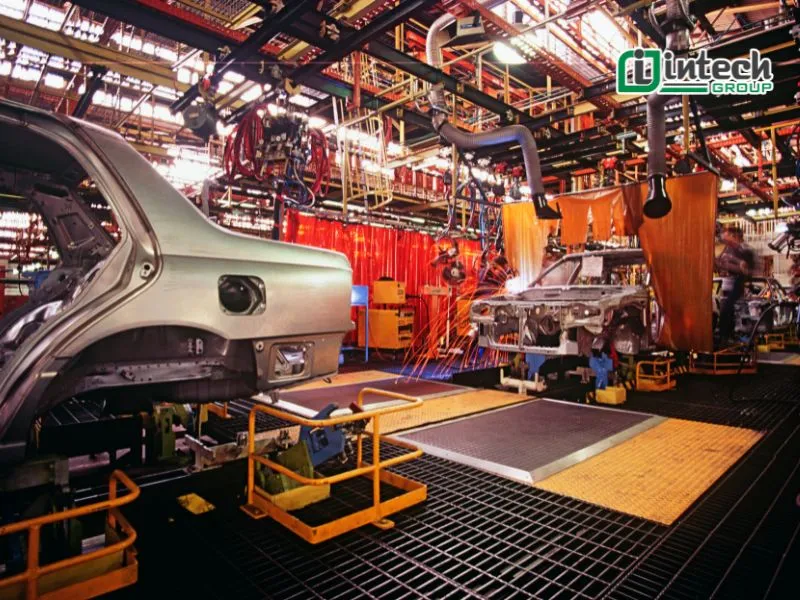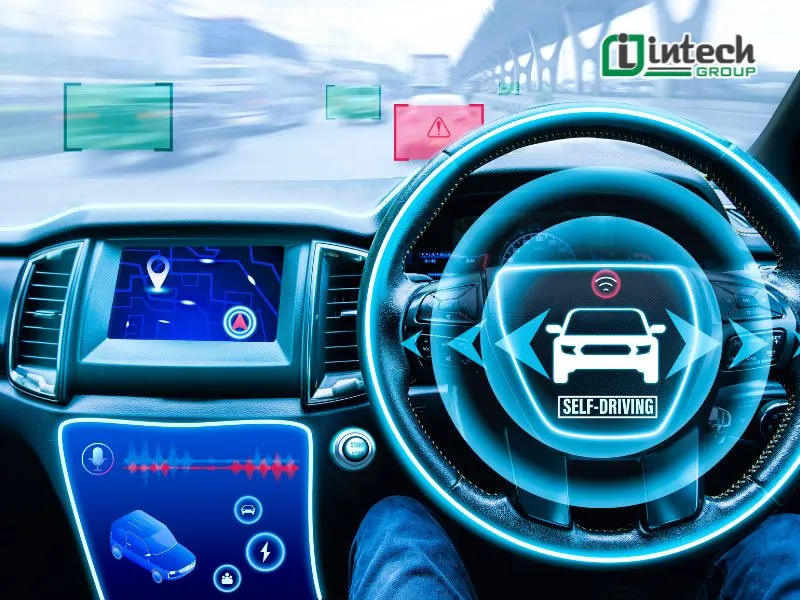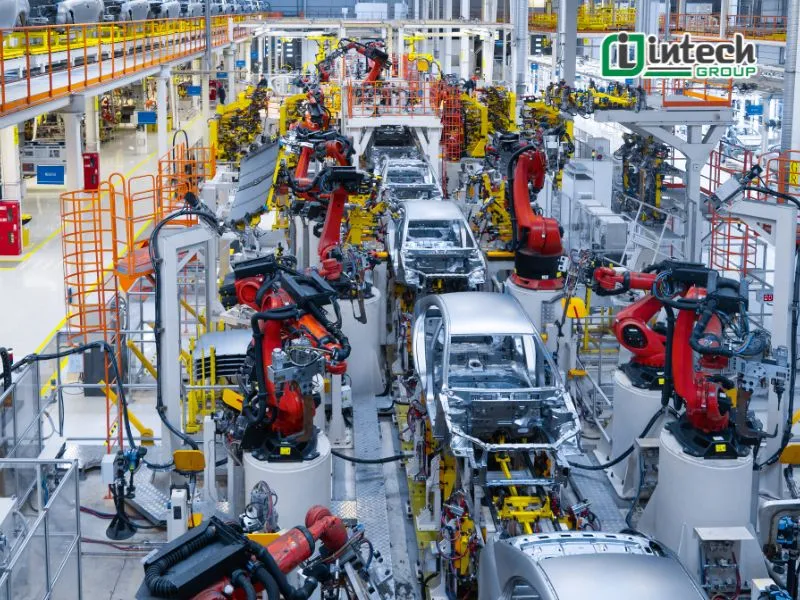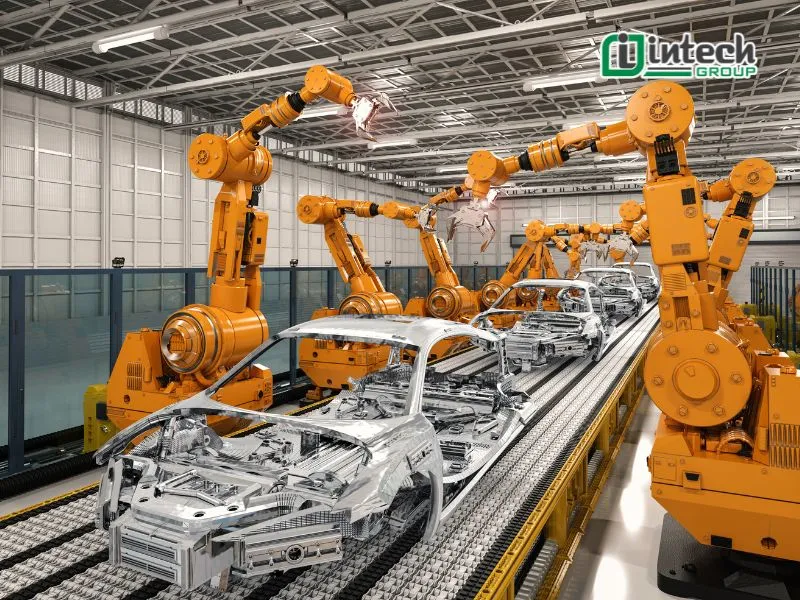Automation in Automotive Manufacturing: Trends and Challenges
11-08-2025 103
Automation in automobile manufacturing is becoming an inevitable trend, helping factories increase productivity, improve quality and reduce production costs. Thanks to robotic technology, artificial intelligence (AI) and intelligent control systems, automobile production lines are becoming more modern, precise and efficient. This development not only meets market demand but also pushes the automobile industry further into the digital age.
Mục lục
The important role of Automation in Automotive Manufacturing
Automation has become an indispensable factor in the automotive manufacturing industry, helping to improve efficiency, quality and competitiveness. Here are the important roles of automation in this field, explained in an easy-to-understand way:
- Increase productivity and production efficiency
Automation helps shorten production time, allowing factories to assemble more cars in a short period of time. Thanks to the support of robotic systems and automatic production lines, the production process is continuous, minimizing interruptions due to human factors.
Robotic arms can perform tasks such as welding, assembling and painting at high speed, while ensuring absolute precision. This helps businesses increase production without having to expand the scale of human resources too much.
For example, welding robots can complete hundreds of welds on the car body in just a few minutes, while manual work takes hours.

- Improve product quality
One of the biggest benefits of automation is improving product quality. Robotic systems operate according to precise programming, helping to minimize human errors.
In addition, sensor technology and artificial intelligence (AI) integrated into the production line help to check product quality in real time. Any errors, no matter how small, are detected and adjusted promptly, ensuring that each vehicle leaving the factory meets the highest standards.
- Reduce production costs
The application of automation helps businesses significantly reduce labor costs, while optimizing the use of resources. Instead of needing many workers to perform assembly, welding or product inspection stages, factories can use robots to complete these tasks with higher efficiency.
In addition, thanks to precise control systems, businesses also reduce waste of raw materials, contributing to saving production costs and increasing profits.
- Increased safety at work
In the automotive industry, there are many jobs that have a high risk of occupational accidents, such as welding, painting, assembling heavy parts or working in hazardous environments. Using machines and robots to replace humans in these stages helps to significantly reduce the risk of injury.
At the same time, automation also contributes to improving working conditions for workers, helping them focus on monitoring and controlling system tasks instead of directly participating in dangerous jobs.
Automation trends in automotive manufacturing
- Artificial intelligence (AI) in automotive manufacturing
Artificial intelligence (AI) plays an important role in the entire value chain of the automotive industry, from design and manufacturing to maintenance and insurance services. This technology is driving major changes, especially in the fields of self-driving cars, car manufacturing and improving customer experience.
AI is at the core of advanced driver assistance systems (ADAS), which perform functions such as lane keeping, adaptive cruise control, and collision avoidance. AI is capable of processing real-time data from cameras, LiDAR, radar, and other sensors to make instant driving decisions. At the same time, AI also helps self-driving cars predict the behavior of other vehicles on the road, improving overall safety.
In the car manufacturing process, AI improves predictive maintenance and quality control. AI systems can monitor machines and predict when maintenance is needed, helping to prevent breakdowns and reduce downtime. In addition, AI-based computer vision technology can detect defects in the manufacturing process with higher accuracy than humans.
AI also plays an important role in enhancing the user experience, through in-car virtual assistants and vehicle-to-everything (V2X) communication systems. This allows the car to interact with other vehicles, traffic infrastructure, and even pedestrians.
A prime example is the BMW Intelligent Personal Assistant, which allows drivers to control many in-car functions, from seat temperature adjustment to directions, with just a simple voice command. It can be seen that AI is strongly promoting automation in the automotive industry and will continue to expand its scope of application in the future.

- Development of self-driving cars
One of the most notable applications of automation today is in the field of transportation, especially driver assistance technology and the development of self-driving cars. Currently, fully autonomous cars are not widely deployed, but major automakers have begun to introduce advanced driver assistance systems (ADAS). These systems allow cars to automatically control tasks such as steering and speed adjustment, while the driver still has to maintain concentration.
Although self-driving cars are not yet common on the road, automated guided vehicles (AGVs) are already widely used in automobile manufacturing plants. For example, at the Mercedes-Benz Türk plant in Aksaray, Turkey, KUKA Robotics Corporation's omnidirectional mobile platforms are supporting connectivity between assembly areas, optimizing production processes with high flexibility.
The development of self-driving technology will continue to accelerate in the coming time, as automakers continue to research and improve technology towards a safer and smarter transportation future.
- Automation in electric and hybrid vehicle production
According to the International Energy Agency (IEA), electric vehicle sales (including pure electric vehicles and plug-in hybrid vehicles) will reach about 14 million units in 2023, up 35% compared to 2022 and six times higher than five years ago. With the support of tax incentives and commitments from automakers, this number is expected to continue to grow strongly in the coming years.
Automation plays an important role in the production and maintenance of electric and hybrid vehicles. In the battery manufacturing process, automated systems help to accurately perform important steps such as electrode production, battery cell assembly and electrolyte pumping. Robotic arms are used in battery assembly to ensure consistency and safety. An automated battery management system (BMS) monitors battery condition, temperature and charge level, thereby automatically optimizing battery performance and life.
At the Mercedes-Benz plant in Kamenz, Germany, many advanced automation technologies have been deployed on the battery production line, helping to improve the efficiency and accuracy of the process.
In addition, the energy regeneration system in electric and hybrid vehicles also relies on automated technology to optimize performance. Regenerative braking systems convert kinetic energy into electricity when a vehicle decelerates or brakes. Sensors and automated controllers determine when and how to apply regenerative braking to recover energy most effectively, working in conjunction with conventional braking systems.
These automation technologies make the production and operation of electric and hybrid vehicles faster and more efficient, helping to meet the growing demands of consumers around the world.

- Automation in the automotive factory
Automation is present in almost every stage of the automotive manufacturing process. Technologies such as robotics, motion control systems, computer vision, and artificial intelligence (AI) work together to perform critical tasks, from welding and assembly to product inspection and testing.
However, the level of automation varies from automaker to automaker. Some manufacturers still use semi-automated processes, where humans still play a key role in quality control and compliance. Others use automated machines to perform specialized tasks or deploy fully automated production lines, where products are transferred from one machine to another without human intervention.
The BMW plant in Dingolfing, Germany, is a prime example of advanced automation being applied to every stage of production, from initial assembly to final quality control.
A handful of factories today are fully automated, operating 24/7 without human supervision. These plants represent a major step forward in the automotive industry, helping to increase efficiency and reduce operating costs.
- Industry 4.0 and Smart Manufacturing
Industry 4.0, also known as the Fourth Industrial Revolution, is changing the way automotive companies operate. Thanks to the integration of advanced technologies such as the Internet of Things (IoT), cloud computing and Big Data, automation is now embedded in every aspect of the value chain, from component suppliers to end consumers. This makes the automotive industry more connected and flexible than ever.
This transformation also contributes to the promotion of smart manufacturing, where advanced technologies make the manufacturing process smarter and more optimized. In the automotive industry, some important applications of smart manufacturing include:
- Using robots in vehicle assembly, increasing accuracy and reducing errors.
- Predictive maintenance using IoT and AI, which helps monitor machinery in real time and prevent breakdowns before they occur.
- Digital Twin technology, which allows simulation and optimization of production processes without the need for physical testing.
- Thanks to Industry 4.0 and smart manufacturing, automakers can quickly respond to the increasing complexity of modern vehicles, while improving performance and optimizing costs.
- Computer vision in quality control
Machine Vision automates precision inspection tasks in the automotive industry. Computer vision systems equipped with high-resolution cameras and AI algorithms can scan the surface of automotive parts to detect defects, comparing real-time images with pre-established quality standards. This technology can detect very small details that are difficult for the human eye to perceive.
By taking pictures and making precise measurements, computer vision systems ensure that critical components such as engines and braking systems are manufactured to specifications. In addition, this technology is also used to check the precise assembly of parts, ensuring that no components are missing and everything is properly aligned. With the help of computer vision, the automotive industry is improving product quality, minimizing defects and improving vehicle safety when leaving the factory.
- Robotic Process Automation (RPA)
Robotic Process Automation (RPA) uses robotic software to automate repetitive, rule-based tasks, often related to business processes. Due to its ease of implementation and ability to deliver a quick return on investment (ROI), RPA is becoming an important technology with strong potential for future growth.
In the automotive industry, RPA helps perform tasks that were previously time-consuming and labor-intensive, such as:
- Warehouse and transportation management, helping to track inventory and optimize the supply chain.
- Supplier onboarding and management, ensuring fast and accurate collaboration processes.
- Legal compliance, helping to automatically check and process paperwork.
- Order processing, helping to minimize errors and speed up transactions.
Thanks to RPA, businesses in the automotive industry can improve accuracy, reduce operating costs and optimize working time, helping employees focus on more important tasks instead of procedural work.
- Robots and Cobots in Automotive Manufacturing
The application of robots in automotive manufacturing has significantly changed the vehicle assembly process. Assembly robots can work faster, more accurately than humans, and are easier to deploy than some specialized equipment. In car manufacturing plants, robot arms undertake many important tasks such as:
- Screw driving
- Windshield installation
- Wheel mounting
The use of robots not only increases production output and efficiency, but also helps reduce costs and limit risks for workers.
For example, the automated vehicle plug-in system developed by FANUC for General Motors eliminates mechanical stress from manual work while significantly improving production times.
+ Cobots – Collaborative Robots in Automotive Manufacturing
Collaborative robots (Cobots) are a more flexible solution than traditional industrial robots. Cobots are lighter and more compact in design, making them easier to integrate into existing manufacturing spaces without changing the factory structure.
In addition to optimizing manufacturing space, cobots also help reduce adjustment costs when adding or changing product content on the assembly line.
In the automotive industry, cobots are often used to perform tasks that require awkward postures that can easily cause injury to humans. According to Universal Robots, cobots help eliminate activities that cause muscle fatigue and affect employee health, thereby improving the working environment. Unlike traditional robots that must be kept in separate areas, cobots can work alongside humans, increasing production speed and efficiency. In addition, cobots can work together to improve production efficiency. For example, an FCC Industrial Systems factory in the Czech Republic deployed multiple ABB Inc. Single-Arm YuMi® collaborative robots to automate the part loading process, optimizing production operations.
The Challenge of Automation in the Automotive Industry
Automation is revolutionizing the automotive industry, increasing productivity, reducing costs and improving product quality. However, this process also faces many major challenges, from investment costs, labor skills requirements to cybersecurity risks and manufacturing flexibility.
- High initial investment costs
One of the biggest challenges of automation in the automotive industry is the high initial investment costs. Deploying industrial robots, artificial intelligence (AI), the Internet of Things (IoT) and automated systems requires a large amount of capital. In addition to the cost of purchasing equipment, businesses also have to invest in:
- Infrastructure, including factories, electrical systems and data networks.
- Maintenance and upgrade costs to ensure stable and optimal system operation.
- Training staff, as employees need to be equipped with the knowledge to operate and monitor automated systems.
Not all businesses have the resources to invest in automation, especially small-scale manufacturers.
- Lack of highly skilled human resources
Although automation reduces the need for manual labor, it creates a high demand for highly skilled human resources. Automotive manufacturers need a team of engineers and experts who can:
- Operate, program, and maintain robots.
- Analyze data from AI and IoT to optimize production processes.
- Monitor and troubleshoot automated production lines.
However, the shortage of skilled labor is becoming a major barrier to automation. Without enough experts to manage the system, implementing new technology will be difficult and can lead to production disruptions.

- Cybersecurity risks
Automation means that auto factories must be connected to big data networks, using IoT, AI and cloud computing systems to operate. This makes the auto manufacturing industry an attractive target for cyberattacks.
Some of the cybersecurity risks in automation include:
- Attacks on production systems, disrupting assembly lines.
- Theft of important data, such as vehicle designs, customer information or proprietary technology.
- Infecting control systems with malware (malware, ransomware), causing severe damage.
Manufacturers need to invest heavily in cybersecurity, including data encryption, security monitoring systems and employee training on cybersecurity risks.
- Lack of flexibility in production
Another challenge of automation is the lack of adaptability to changes in production. Robots and automated systems are often designed to perform repetitive tasks with high precision. However, if there is a change in product design or manufacturing process, these systems may have to:
- Reprogram from scratch, which is time-consuming and expensive.
- Change or upgrade equipment, which requires large investment costs.
- Disrupt production operations, affecting delivery schedules.
Meanwhile, humans are more flexible in adapting to sudden changes. Therefore, businesses need to find a balance between automation and human resources to maintain production efficiency.
- Impact on workers' jobs
The development of robots and AI in automobile manufacturing may lead to job losses in some traditional labor sectors. Jobs such as:
- Assembling basic components.
- Visually checking product quality.
- Operating simple machinery.
are at risk of being replaced by automated systems. This raises concerns about rising unemployment and imbalances in the labor market.
To mitigate this impact, businesses need to have a reskilling strategy, helping employees adapt to new technologies and move to higher-value positions.
Automation not only helps the automotive industry grow strongly but also opens up many opportunities for innovation and sustainable development. Although there are still some challenges, with investment in technology and human resources, the automotive industry will continue to optimize production processes, bringing high-quality and more environmentally friendly products. In the future, automation promises to continue to shape and revolutionize the global automotive industry.
To mitigate this impact, businesses need to have a reskilling strategy, helping employees adapt to new technologies and move to higher-value positions.
Automation not only helps the automotive industry grow strongly but also opens up many opportunities for innovation and sustainable development. Although there are still some challenges, with investment in technology and human resources, the automotive industry will continue to optimize production processes, bringing high-quality and more environmentally friendly products. In the future, automation promises to continue to shape and revolutionize the global automotive industry.


